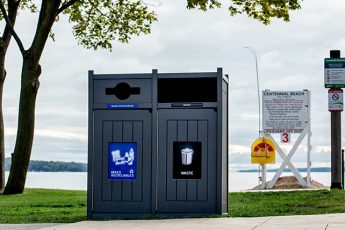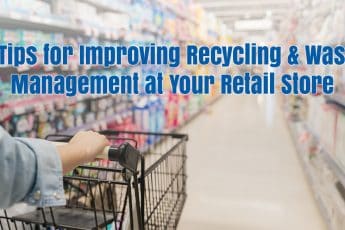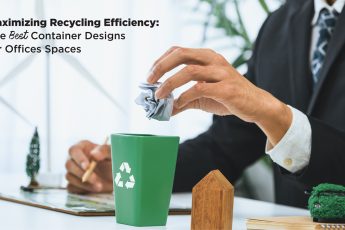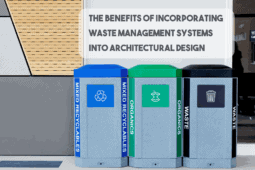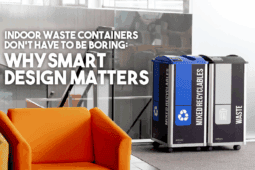
September 21, 2025 By MacKenzie Bradbury No Comments
Hotels and resorts produce an enormous amount of waste—thanks to frequent guest turnover and the demands of daily operations. In fact:
-
One source estimates hotels generate 289,700 tons of waste every year.
-
A 2018 study of 120 hotels found that of this waste, 58.5% was biodegradable (food waste), 25.8% recyclables, and 15.7% other.
-
That same study noted that among the hotels surveyed: 76% had launched sorting programs, 39% had recycling in place, 29% were working on reduction, but only 0.8% had composting.
With a thoughtful waste-management program, your property can improve its environmental footprint and reduce costs while enhancing your brand image. An effective program rests on three pillars: reduce, reuse, and recycle. Without it, excess waste, high disposal costs and reputational risk can become a burden.
Here are nine key strategies to make your lodging waste-management program truly effective.
1. Conduct a Waste Audit
Start by identifying and quantifying the types of waste generated in every area of your property — rooms, restaurants, offices, recreation zones, etc. Use a map of your grounds and tag key zones.
For example:
-
Front desk & administrative offices → paper, brochures, printed documents
-
Guest rooms → cans, bottles, cardboard packaging
-
Restaurant & food prep areas → fruit and vegetable peels, floral waste, organic scraps
Sorting and color-coding bins by stream (organic, recyclable, landfill) makes it easier for staff and guests to drop waste in the right place — reducing contamination and improving efficiency.
2. Build a “Green Team”
Do your facilities or operations teams have extra bandwidth for new sustainability initiatives? If not, assemble a dedicated internal group—a “Green Team”—whose purpose is to educate, empower and inspire colleagues toward sustainable practices.
Tips for success:
-
Give the team formal oversight and clearly defined responsibilities.
-
Provide measurement tools and verification processes to track progress.
-
Give the team a clear mission statement and visible support from leadership.
Without this kind of internal advocacy, new waste-program initiatives often stall or fail to gain momentum.
3. Communicate the Program to Your Guests
Because resort guests are mostly short-term visitors, they may not know how your waste-management program works. You often have only seconds to educate them.
Consider:
-
Use clear, colourful signage with graphics or photos of typical items that belong in each stream (recycle, compost, landfill).
-
Account for multi-language guests and international visitors.
-
Ensure consistency in signage and bin design throughout the property so messaging is intuitive.
-
Train staff to talk about the program — when employees are informed, they can reinforce guest behaviour.
4. Adjust Operational Habits
Your day-to-day operations present high-leverage opportunities for waste reduction. Small changes can yield big results.
Here are some examples:
-
Replace single-use cleaning-product bottles with refillable dispensers in guest rooms.
-
Use durable dishware instead of disposable plates in dining areas—waste is reduced and guest perception is elevated.
-
Install water-fountains or bottle-filling stations rather than selling plastic bottles on each floor.
-
Avoid using paper products (outside of necessary items like toilet-paper) in bathrooms and common areas.
-
Upgrade to LED lighting — LED bulbs last significantly longer than conventional ones, which means fewer replacements (less waste) and lower energy usage.
5. Implement In-Room Recycling Programs
Every guest room matters. While it may seem that high-traffic zones create the most waste, guest rooms themselves add up—and can represent significant savings when properly managed.
For example: the hotel chain Kimpton Hotels & Restaurants reported savings of approximately $267,300 a year through in-room recycling programs. They noted that cardboard recycling alone ranged from $12,000–$20,000 per year in savings per property.
6. Eliminate Single-Use Plastics
Many brands are already moving away from one-time plastics—from straws to toiletry bottles.
Replacing single-use items with reusable alternatives reduces environmental impact and lowers waste-collection and disposal costs (often associated with litter cleanup, tipping fees, etc.).
7. Re-evaluate Disposal Habits
Historically, many hotels sent all waste to landfills or incineration without sorting. Today there are better options.
Food waste is commonly the largest stream in a hotel environment. If there’s a hauler in your region that collects organics/compost separately, this can help reduce landfill waste and cost. Alternatively, you might invest in onsite food-waste composting.
8. Choose the Right Recycling Stations
Successful recycling programs depend on having well-designed collection stations in the right locations.
Here are some factors to consider:
-
Placement: Stations must be conveniently located relative to guest and staff activity zones.
-
Climate/Environment: Outdoor vs indoor, high-humidity zones, etc.
-
Capacity: The right size and frequency of collection to prevent overflow and contamination.
-
Restrictive Openings: Design bins so people are guided to use the correct stream (e.g., bottle-slots, paper-slots).
-
Signage & Customization: Use clear branding, consistent visuals, colour-coding and graphics to indicate streams.
If recycling/compost bins are not adjacent to trash bins, guests will often default to the nearest bin — leading to contamination and undermining your diversion efforts.
9. Set Sustainability Standards for Your Vendors
You should control the materials entering your property—particularly high-volume items such as packaging, soap bottles, single-use plastics and food packaging.
By communicating clear standards to your vendors—choosing more sustainable alternatives—you can significantly reduce waste entering your system, thus lowering your disposal costs and supporting your brand’s sustainable image.
In Summary
Start your waste-management program on the right foot by implementing these nine industry-tested strategies. Once your program is launched, you’ll continue to identify new areas of improvement—both minor tweaks and major initiatives. Over time, you’ll improve your diversion rate, reduce costs and strengthen guest loyalty through your commitment to sustainability.
Need help getting started? Contact us to chat with our Resort Waste Management Specialists for more direction on where to begin your journey to waste-management excellence.
For more information on how to build an exceptional recycling program for your hotel resort, click here.
Key Takeaways (TL;DR)
-
Hotels and resorts produce huge amounts of waste—food/organic waste is often the largest component (~58.5%) in surveyed hotels.
-
A strong waste-management program helps reduce costs, boost brand image, and improve environmental impact.
-
Nine foundational strategies:
-
Conduct a waste audit to map & quantify all waste streams across your property.
-
Establish a dedicated Green Team of employees to champion and monitor sustainability efforts.
-
Communicate clearly with guests and staff—use consistent, multilingual visuals and signage for bins and streams.
-
Modify operational habits to reduce waste at source—e.g., refillable dispensers, reusable dishware, water fountains instead of bottled water.
-
Implement in-room recycling—even small waste streams at the room level can yield significant savings once scaled.
-
Eliminate single-use plastics (e.g., straws, toiletry bottles) to cut disposal costs and waste.
-
Re-evaluate disposal habits: transition from landfill-only to composting/organics hauling or on-site food-waste composters.
-
Choose the right recycling stations: proper placement, capacity, signage and stream separation matter to reduce contamination.
-
Set sustainability standards for vendors and packaging to reduce upstream waste and disposal costs.
-
-
Launching the program is just the beginning—ongoing improvement, measurement and adaptation will increase diversion rates, reduce costs and strengthen your sustainability brand.
